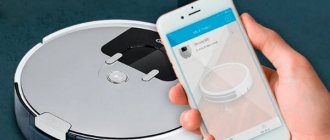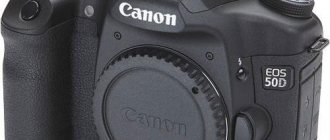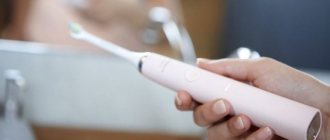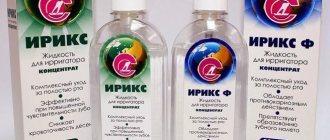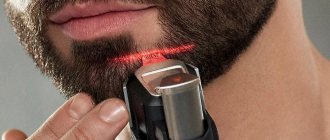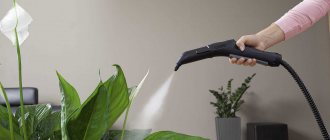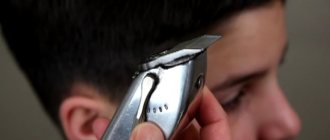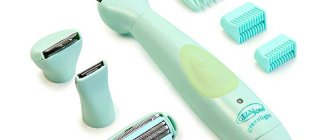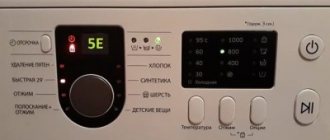- How does the irrigator work?
- How often to use a waterpik
- What to put in the irrigator? Water, balms?
- Am I holding the waterpik incorrectly?
- How to choose pressure
- Why are attachments needed?
- Can a child use a waterpik?
- Will an irrigator replace a toothbrush?
- Cleaning braces with an irrigator
The tips collected here will be useful both to those who have already purchased and to those who are just about to choose an oral irrigator. These are our specialists' answers to frequently asked questions from clients. We wrote earlier about how to choose an irrigator.
How does the irrigator work?
An irrigator is a special device for oral hygiene that provides the highest quality care. During operation, water or a special liquid under pressure is supplied from the reservoir. Irrigator nozzles direct water to those areas of the oral cavity where it is impossible to reach with a toothbrush or floss. There, the water, due to pulsations, cleanses the interdental spaces and massages the gums.
The device cleans all surfaces of teeth, gums, tongue, interdental space, dentures and orthodontic structures. In this case, the water pressure can be adjusted.
Why do you need an irrigator?
In this article
- Why do you need an irrigator?
- Which dental irrigator should you choose?
- How to use an oral irrigator?
- How to properly use an irrigator to clean braces?
- How to clean the irrigator after use?
- Which attachment is better to use?
Even a child knows that you need to brush your teeth twice a day - in the morning after breakfast and in the evening before bed. The rules of oral hygiene involve not only removing bacteria and plaque from the surface of the teeth with a toothbrush, but also cleaning the interdental spaces with a special floss. If you do not remove microscopic food debris that accumulates between your teeth, this can lead to the development of caries and gum inflammation. But dental floss cannot always clean the space between teeth efficiently. There are hard-to-reach places where it is impossible to reach. And some people have very sensitive gums that begin to bleed when flossing. A modern alternative or addition to traditional methods of brushing teeth is an irrigator. Another name for this device is a water flosser.
The principle of operation of the device is to irrigate the oral cavity with a powerful stream of water or a special cleaning solution. The liquid is supplied under pressure, which can be adjusted, and special nozzles allow it to be directed to those areas that require thorough cleaning. With the help of an irrigator, you can easily remove food debris, bacteria, and plaque in the most difficult areas without injuring your gums. The device is used for gentle cleaning not only of teeth, but also of crowns, dental implants, bridges, and braces.
What to put in the irrigator? Water, balms?
Drinking, bottled water, and saline solutions are suitable for the irrigator. The water should be at room temperature. Hot water harms the irrigator, and cold water damages the teeth. You can also use tap water if it is not too hard. Herbal infusions can cause deposits in the irrigator system, causing it to need to be cleaned more often than usual, or even breaking the device. Dentists recommend using special balms that can be added to the water before procedures.
- Balms kill pathogenic bacteria.
- Freshen your breath.
- They are carefully filtered, so they do not clog the irrigator with microparticles.
- They do not foam inside the device, unlike mouth rinses.
- They do not leave sediment like herbal infusions.
- They have an anti-inflammatory and healing effect.
How to properly use an irrigator to clean your teeth and mouth
The instructions for using the oral irrigator are quite simple. It is important to brush regularly, give equal attention to the front and back teeth, and adhere to the recommended duration of treatments.
The irrigator should be used before or after brushing your teeth
For high-quality oral hygiene, it is necessary to use a dental device only in conjunction with a regular brush. The unit is used after traditional teeth cleaning to remove those dirt and deposits that the bristles did not reach.
How to properly brush your teeth with an irrigator
To completely remove stains from teeth and gums, you must adhere to the rules for using the irrigator. The oral cavity treatment algorithm looks like this:
- First, carry out regular brushing of your teeth with a brush. In the absence of contraindications, it is also recommended to use thread for treating narrow crevices.
- After the procedure, they begin cleaning using a special device. The container of the device is filled with filtered water or an antiseptic solution; before use, it is recommended to warm the liquid to room temperature.
- The required attachment is installed on the device. Standard cleaning is carried out using a regular tooth and gum tip. But sometimes it is more convenient to use special attachments for artificial structures or for tongue treatment.
- The device is placed in the oral cavity. When you start brushing, the tip of the nozzle should be located approximately in the area of your molars. At the same time, you need to hold the irrigator so that it does not touch the gums or enamel surface.
- The desired mode and jet pressure are set for the device. It is recommended to start brushing with a low pressure and then gradually increase it so that the impact on the teeth is not too strong and harsh.
- The device is turned on and the oral cavity is carefully processed. You should move from the back teeth to the front teeth along the gum line. It should take about 30 seconds to clean each side of your mouth. In this case, 2-3 seconds are spent on individual teeth. The nozzle is positioned at an angle of 90 degrees to the surface and the jet is alternately directed at the enamel from both the outer and inner sides.
The mouth must be kept slightly open during the procedure so that the used solution immediately flows into the sink. It is recommended to clean while leaning slightly over the sink. If desired, you can close your lips around the nozzle, but this will increase the risk of swallowing liquid.
It is not recommended to swallow the used solution, as pathogenic bacteria remain in it after cleaning.
How often and how many times a day can you use a dental irrigator?
The irrigator can be used every day - this will provide the highest quality oral care. For healthy teeth and gums, it is recommended to use the device twice a day after brushing, morning and evening.
If you have dental disease, you should be careful. Usually, in agreement with the doctor, a special device is used in such cases 2-3 times a week, and it is necessary to fill the reservoir with a disinfectant solution rather than water. The jet pressure is set to low so as not to damage weakened gums and mucous membranes.
Warning! Daily use of an irrigator harms sensitive tooth enamel. The device should be used no more often than every other day, and at minimum power.
Is it possible to use one irrigator for the whole family?
Videos about using the irrigator confirm that one device can be used by several people at the same time. Even budget devices cost much more than a toothbrush, and it is irrational to buy a personal device for each family member.
In this case, you need to ensure that all users of the unit have individual nozzles. If there are too few replacement tips included with the device, the required number can be purchased separately. Using other people's attachments when using the irrigator is strictly prohibited. This seriously increases the risk of contracting viral and infectious diseases, and not only dental ones.
When using the irrigator as a family, it is recommended to purchase attachments with colored rings
Why are attachments needed?
The attachments expand the list of useful properties of the irrigator: they clean gum pockets and additionally clean the enamel from plaque. Standard brush heads should be changed approximately once every six months, brush heads with bristles or rubber bands should be changed once every 3 months, like a toothbrush.
Let's look at what types of nozzles there are.
- Standard
. If you do not have any special diseases or structures in your mouth, a standard attachment will suit you. It has no bristles and looks like an angled tube. This nozzle thoroughly and effectively washes away plaque and food debris. As a rule, most irrigators come with two such attachments. - Orthodontic
. It is a curved tube with a bunch of bristles at the end and is used for braces and other structures - crowns, bridges, dentures. The combination of mechanical action and a jet of water allows you to clean the spaces between the teeth and the arches of braces and remove plaque from hard-to-reach places. - Periodontal
. Designed for periodontal pockets. Its tip is made of soft silicone or rubber and does not injure sensitive gums. Such a nozzle cannot be used at maximum power - it itself creates additional pressure, and with strong pressure its tip can fly off or break. - Spoon attachment
. The spoon-shaped attachment is used after brushing your teeth to remove plaque from the surface of the tongue, cheeks and palate. - Brush attachment
. Used as a toothbrush in combination with a stream of water. Cleans teeth, crowns, dentures well. Suitable for daily use. It is important to remember that this attachment will not replace a toothbrush. In addition, her stubble is very hard. - Nasal attachment
. Used to clean nasal cavities.
Irrigator or toothbrush?
Some not very conscientious sellers of dental hygiene products advertise irrigators as universal devices for cleaning the oral cavity that can replace a toothbrush, dental floss, and other teeth and gum care products. We urge our readers not to fall for these marketing tricks and remember that a water flosser cannot replace a toothbrush, just like a water flosser toothbrush. These devices perform different functions, although they solve one important task: removing bacterial plaque. But this can be done well when they work together.
A toothbrush destroys a dense film of plaque and destroys the structure of the bacterial mass; The irrigator washes out the remaining dirt, cleans the interdental spaces and periodontal pockets that are inaccessible to the brush.
Therefore, rule No. 1 is to use an irrigator after brushing with a toothbrush.
Cleaning braces with an irrigator
Irrigators with special attachments are considered the most effective way to clean braces and keep your mouth clean while you wear them. When cleaning braces, you should follow a few simple rules.
- Start with the far teeth
. - Clean each bracket separately
. Pay special attention to the clasps and structural elements that fit tightly to the enamel. - After this, move on to the interdental space and gums
.
It would also be a good idea to use special balms and irrigator solutions, including antiseptic ones, since lips and cheeks often become inflamed while wearing braces.
The best way to refill the device tank
What is the best dentifrice to put in the reservoir? The liquid, first of all, must have a comfortable temperature. To cleanse the oral cavity of plaque and food debris, filtered or distilled water is suitable - it will do the job well and will not damage the parts and “insides” of the device. If you use running water from the tap, then it is better to settle it before use, because the quality may be quite poor, it may contain various impurities, sand particles, debris - all this can become clogged in the device and lead to a malfunction.
Important! Read the instructions carefully before use. There are models in which it is forbidden to pour anything other than ordinary water, in which case various balms and rinses can lead to premature failure of the device.
If the goal is not only to remove contaminants, but also to have a therapeutic effect on the enamel and gums, then, depending on the problem, you can select a specialized liquid with a hemostatic, strengthening, and antiseptic effect. When choosing a composition, make sure that it is specialized and suitable for your device. But you should not experiment with decoctions of various herbs - if you do not strain the decoction well enough, then particles of herbs and plants may subsequently become clogged inside the device, and not every model can be disassembled and cleaned.
Remember that when using specialized liquids, foam may form, so after hygiene procedures the tank will need to be rinsed with water.
